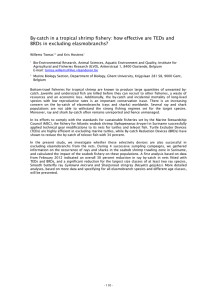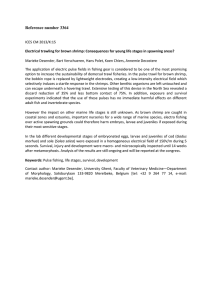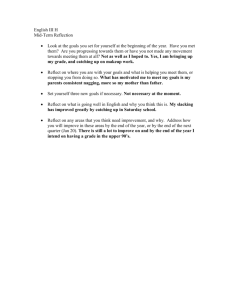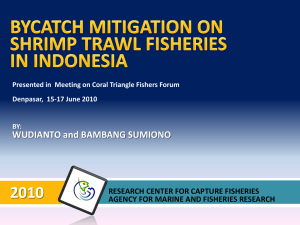International Journal of Fisheries and Aquatic Sciences 1(2): 129-133, 2012
advertisement
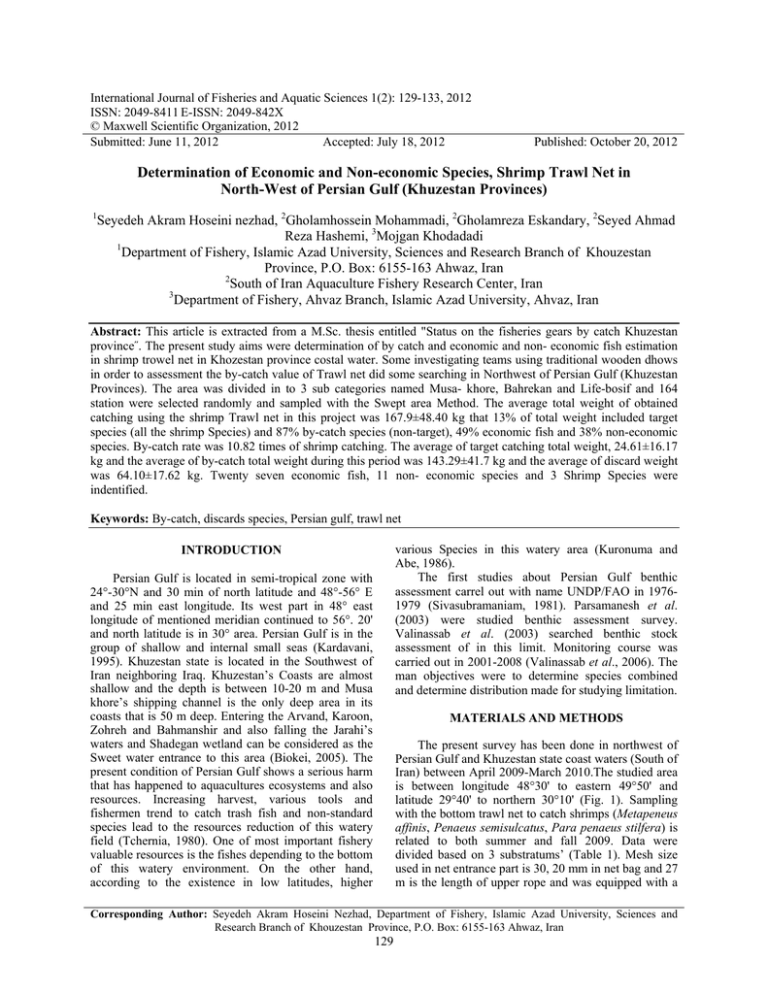
International Journal of Fisheries and Aquatic Sciences 1(2): 129-133, 2012 ISSN: 2049-8411 E-ISSN: 2049-842X © Maxwell Scientific Organization, 2012 Submitted: June 11, 2012 Accepted: July 18, 2012 Published: October 20, 2012 Determination of Economic and Non-economic Species, Shrimp Trawl Net in North-West of Persian Gulf (Khuzestan Provinces) 1 Seyedeh Akram Hoseini nezhad, 2Gholamhossein Mohammadi, 2Gholamreza Eskandary, 2Seyed Ahmad Reza Hashemi, 3Mojgan Khodadadi 1 Department of Fishery, Islamic Azad University, Sciences and Research Branch of Khouzestan Province, P.O. Box: 6155-163 Ahwaz, Iran 1- 2South of Iran Aquaculture Fishery Research Center, Iran 3 Department of Fishery, Ahvaz Branch, Islamic Azad University, Ahvaz, Iran Abstract: This article is extracted from a M.Sc. thesis entitled "Status on the fisheries gears by catch Khuzestan province˝. The present study aims were determination of by catch and economic and non- economic fish estimation in shrimp trowel net in Khozestan province costal water. Some investigating teams using traditional wooden dhows in order to assessment the by-catch value of Trawl net did some searching in Northwest of Persian Gulf (Khuzestan Provinces). The area was divided in to 3 sub categories named Musa- khore, Bahrekan and Life-bosif and 164 station were selected randomly and sampled with the Swept area Method. The average total weight of obtained catching using the shrimp Trawl net in this project was 167.9±48.40 kg that 13% of total weight included target species (all the shrimp Species) and 87% by-catch species (non-target), 49% economic fish and 38% non-economic species. By-catch rate was 10.82 times of shrimp catching. The average of target catching total weight, 24.61±16.17 kg and the average of by-catch total weight during this period was 143.29±41.7 kg and the average of discard weight was 64.10±17.62 kg. Twenty seven economic fish, 11 non- economic species and 3 Shrimp Species were indentified. Keywords: By-catch, discards species, Persian gulf, trawl net various Species in this watery area (Kuronuma and Abe, 1986). The first studies about Persian Gulf benthic assessment carrel out with name UNDP/FAO in 19761979 (Sivasubramaniam, 1981). Parsamanesh et al. (2003) were studied benthic assessment survey. Valinassab et al. (2003) searched benthic stock assessment of in this limit. Monitoring course was carried out in 2001-2008 (Valinassab et al., 2006). The man objectives were to determine species combined and determine distribution made for studying limitation. INTRODUCTION Persian Gulf is located in semi-tropical zone with 24°-30°N and 30 min of north latitude and 48°-56° E and 25 min east longitude. Its west part in 48° east longitude of mentioned meridian continued to 56°. 20' and north latitude is in 30° area. Persian Gulf is in the group of shallow and internal small seas (Kardavani, 1995). Khuzestan state is located in the Southwest of Iran neighboring Iraq. Khuzestan’s Coasts are almost shallow and the depth is between 10-20 m and Musa khore’s shipping channel is the only deep area in its coasts that is 50 m deep. Entering the Arvand, Karoon, Zohreh and Bahmanshir and also falling the Jarahi’s waters and Shadegan wetland can be considered as the Sweet water entrance to this area (Biokei, 2005). The present condition of Persian Gulf shows a serious harm that has happened to aquacultures ecosystems and also resources. Increasing harvest, various tools and fishermen trend to catch trash fish and non-standard species lead to the resources reduction of this watery field (Tchernia, 1980). One of most important fishery valuable resources is the fishes depending to the bottom of this watery environment. On the other hand, according to the existence in low latitudes, higher MATERIALS AND METHODS The present survey has been done in northwest of Persian Gulf and Khuzestan state coast waters (South of Iran) between April 2009-March 2010.The studied area is between longitude 48°30' to eastern 49°50' and latitude 29°40' to northern 30°10' (Fig. 1). Sampling with the bottom trawl net to catch shrimps (Metapeneus affinis, Penaeus semisulcatus, Para penaeus stilfera) is related to both summer and fall 2009. Data were divided based on 3 substratums’ (Table 1). Mesh size used in net entrance part is 30, 20 mm in net bag and 27 m is the length of upper rope and was equipped with a Corresponding Author: Seyedeh Akram Hoseini Nezhad, Department of Fishery, Islamic Azad University, Sciences and Research Branch of Khouzestan Province, P.O. Box: 6155-163 Ahwaz, Iran 129 Int. J. Fish. Aquat. Sci., 1(2): 129-133, 2012 Fig. 1: Studied catching place in Bahrekan, Musa khore and Lifeh Booseif Table 1: The number of trawl stations in proportion to substratum in the West Northern of Persian gulf waters Substratum Longitudes E Latitudes N Area (nm2) Bahrekan 49°, 20´ 30°, 08´ 300 Mousa Khore 48°, 50´ 30°, 55´ 250 Lifeh-Boosif 48°, 30´ 29°, 55´ 200 Station 20 22 15 Global Positioning System (GPS), ITI net sounder system, 2 echo sounders. Sampling method: Net drawings took 2 h and then the information related to net drawing features including time, geographical situation, direction and distance and floating speed were recorded in the catching information forms. After bringing up the net, first whole the catch is depleted on the deck and then big samples like shark flounder; big catfish become separate from the catch. After loading the bags, one sample is randomly selected from each 5 bags. Selected bags with big fish become separated from the whole catch. First big species are counted, weighted and registered in forms, then plastic bags containing catch are weighted separately and depleted on the worktable for isolation and whole the existed species are separated, counted and weighted. Sampling identification was done based on present resources (Fishcer and Bianchi, 1984; Bianchi, 1985; FAO, 2001). Excel software and ANOVAs test both side without repetition were used to perform all the calculations and tables drawing are related curves. Deep 20-25 10-20 10-20 weight percentage of target catch, 13% weight percentage of discard catch, 38% weight percentage of by-catch economic fishes, 49% Fig. 2: Total weight percentage of target, economic by-catch and discard trawl net in Khuzestan coasts in Khuzestan coasts in 2009. RESULTS Results showed that 13% of the total catch weight includes target species (all the shrimp species) and 87% are by-catch species (non-target and discard) and 49% 130 Int. J. Fish. Aquat. Sci., 1(2): 129-133, 2012 Table 2: Checklist of species/species groups in bottom trawl catches in the Persian Gulf (2009) and their percentage from total catch Weight in Weight in Musa Weight in Average of Scientific name Bahrekan (%) khore (%) Life-bosif (%) Weight (%) Ecologic group Economical value Pomadasys kaakan 4/69 4/69 Demersal Economic by-catch Acanthopagrus latus 5/5 4/95 4/8 5/08 Demersal Economic by-catch Parastromatcus niger 2/15 2/2 2/17 Demersal Economic by-catch Jeanus spp. 13/7 10/74 10/74 11/75 Demersal Economic by-catch Argyrosomus 0/4 0/3 0/5 0/4 Demersal Economic by-catch holopidotus Scomberomorus 1/33 2/5 2/2 2/01 Pelagic Economic by-catch commerson Scomberoides 0/3 0/4 0/3 Pelagic Economic by-catch commersonnianus IIisha megaloptera 1/8 0/8 1/2 1/2 Pelagic Economic by-catch Eleutheronema 5/14 5/14 Demersal Economic by-catch tetradactylum Platycephalus indicus 1/40 2/7 0/5 1/53 Demersal Economic by-catch Carcharhinus 11/55 8/5 9/5 9/8 Demersal Economic by-catch dussumieri 8 11/85 7/21 9/02 Demersal Non-economic Arius. spp. discard Jellyfish 5 4 4/5 4/5 Pelagic Non-economic discard Portuns pelagicus 4/35 3/5 3/92 Pelagic Economic by-catch Pumpus argenteus 3/14 3/2 3 3/11 Demersal Economic by-catch Chirocentridus spp. 2/8 1/5 0/8 1/7 Pelagic Economic by-catch Siganus spp. 2 2 Demersal Economic by-catch Spardentex hasta 0/25 0/85 0/5 Demersal Economic by-catch Saurida tumbil 5/91 1/2 1 2/70 Demersal Economic by-catch Sphyraena jello 2/62 3/5 2/2 2/7 Demersal Economic by-catch Psettodes erume 2/34 1/39 1/2 1/64 Demersal Economic by-catch Cynogloss arel 12/01 18/81 13/4 14/74 Demersal Economic by-catch Tricantidea 2/67 2/4 2/3 2/4 Demersal Non-economic discard Euryglussa orientalis 2/14 1/74 1/5 1/79 Demersal Economic by-catch Chylusyllum 12/09 4/5 8/2 Demersal Non-economic punctatum discard Lagocephalus inermi 1/14 1/4 0/9 1/14 Demersal Non-economic discard Sillago sihama 3/45 1/69 3 2/71 Demersal Economic by-catch Upeneus sulphureus 7/92 6/5 6/6 7 Demersal Non-economic discard IIisha megaloptera 5/16 5/3 5/4 5/2 Pelagic Non-economic discard Atule mate 2/9 2/8 2/2 2/6 Pelagic Economic by-catch Pomadasys striden 7/82 7/31 7/21 7/4 Demersal Non-economic discard Liza klunzingeri 4/72 3/2 3/2 3/71 Pelagic Economic by-catch Scorponidae 0/83 0/7 0/6 0/7 Demersal Non-economic discard Penaeus semisulcatu 7/79 8/5 8/2 8/16 Pelagic Economic target Metapenaeus affinis 6/88 12/96 6/71 8/85 Pelagic Economic target Parapenaeopsis 10/05 7/04 3/41 6/8 Pelagic Economic target stylifera Leiognathus fasciatus 5/09 12/49 11/3 9/62 Pelagic Non-economic discard Trichiuriurus lepturus 7/03 6/4 6/5 6/6 Demersal Non-economic discard economic and 38% are discard species (Fig. 2). The average total weight of obtained catching using the shrimp Trawl net in this project was 167.9±48.40 kg and the average of target catching total weight, 24.61±16.17 kg and the average of by-catch total weight during this period was 143.29±41.7 kg and the average of discard weight was 64.10±17.62 kg. Twenty seven economic fish, 11 non- economic species and 3 Shrimp Species were indentified. Bilateral without repetition variance analysis indicated the lack of meaningful difference between net trawl by-catch in both summer and fall (p>0/05) and there was no meaningful difference between the by-catch in different studied areas (p>0/05). Species isolation and identification in the family or species limit were done according to the commercial importance. Table 2 shows the identified species in the studied area that has been cached by the trawl net catch and also their weight 131 Int. J. Fish. Aquat. Sci., 1(2): 129-133, 2012 Table 3: Seasonal weight percentage of target, by-catch and discard trawl net in Khuzestan coasts in 2009 Percentage of Percentage of Percentage Season target catch by-catch of discard Summer 23.40 76.60 33 Fall 11.35 88.64 40 Table 4: Weight percentage of target, by-catch and discard trawl net in Khuzestan coasts in 2009 Percentage of Percentage of Percentage Zone target catch by-catch of discard Bahrekan 16 84 35 Musa khore 13 87 37 Lifeh-boosif 9.7 90.3 45.5 percentage in those areas and catch value based on target, by-catch species. In all areas, 43 species have been detected and Cynogloss arel species has the most catch percentage (14.47%) in the whole 3 areas and after that Jeanus sp., with 11.75% is in the second grade Scomberoides commersonnianus has the least catch percentage. According to seasonal scale, the most target species catching weight percentage was 23.4% in summer and the least 11.35 in fall. The most by-catch fishing weight percentage was 88.64 in fall and the least 76.6 in summer and the same matter for unwanted fishing in fall was 40% and the least 33% in summer (Table 3). According Table 4 target catch total weight study in 3 areas showed that Bahrekan had the most amount (16%) and life-Boosif (9.7%) the least. About by-catch, life-Boosif with 90.3% and Bahrekan with 84% has the most and least amount .About discard, Lifeh-Boosif with 45.5% and Bahrekan with 35% has the most and least catching amounts. DISCUSSION Overall result indicates the commercial fishing percentage and then non-commercial species being more than shrimp catching rate. Although in this kind of trawl, shrimp are the target species (because of the net entrance). Nikoo (2006) also said that fish contain the more percentage of whole the catched species with floor trawl. Valinassab et al. (2006) was done on shrimp trawl by-catch in Hormozgan, 27.2% weight of catching combination was shrimp, 49% small fish , 4.7% important commercial species and 18.7% big and almost big species. Cook (2001) in the study of bycatch mixture in shrimp trawl method in Singapore showed that 32% of by-catch was important commercial fish catching species. It means that shrimp catching not only has the negative effect on private catching methods, but also makes problems for economic fish resources management. As the variance analysis results between seasons and reviewed areas showed, there is no meaningful difference in by-catch in summer and fall because of the low selecting percentage and net trawl by-catch being more. The most weight percentage of target catching in seasonal scale is for summer (July-August) and in spatial scale for Bahrekan. The reason may be the high weight percentage of tiger shrimp because it is a part of target catching and because of having higher weight than other shrimp species and its emigration kind (it’s from Booshehr local part and being close to Bahrekan). It contains the high percent of target catching weight in floor net trawl. On the other hand, P. stilifera can be one of the reasons of high weight of target catching. According to Nikoo (2006), there are numerous amounts of shrimp in the late spring (July) till the early summer (August) .Their special presences in Mahshahr’s Khuriat in August confirm the survey result. Garcia and Reste (1981) also indicated that shrimps emigration model in coast areas has started with emigration and entrance of larva's in to shallow coast zone , after that day come out of this stations in order to reproduction. Qasemi and Niamimandi (1990) represented that tiger shrimp spawn in winter to spring and become collected in the mid August to September in Booshehr state. These results match with the present survey result that shows the increasing rate of their presence in summer. By-catch rate was estimated 10.82 times than shrimp catching. The ratio of by-catch to shrimp in net trawl is 7 to 1 (FAO, 2001). Ye et al. (2000) calculated this relation 30 to 1 in Kuwait seas. Among the by catch species, Leiognathus fasciatus has the most catching percentage (9.62). Nikoo (2006) mentioned this fish as the most enormous species in bycatch. Azar (1983) and Niamimandi (1988) in Booshehr seas survey indicated this fish as the dominated species in catching. According to the high numbers of by-catch species in the reviewed survey, shrimp trawl net must have a very important position from the management point of view. Totally, obtained total weight percentage was more in fall and by-catch follows the total catch. The reason why by-catch is higher in fall in life-Boos if is that shrimp catching percentage is lower in these season and area, therefore, by-catch share will be higher and also it goes higher because this area is a good place for spawns. Dehghan (1998), according to the plenty of fish larvas, recognized that the spawning period is mostly in spring and also the early fall. Increasing heat in spring and heat reduction in fall ones are the important agent in spawning (Nikolsky, 1963).The mentioned reasons in trawl net is because of the high percentage of Cynoglossus arel, in this kind of net that is a part of by catch and can be seen more in shallow and turbid waters and so it has caused the by-catch increase in lifeh-Boos if. The mentioned fish inhabit in muddy beds of continental shelf specially in estuaries and is cached mostly in bottom trawl (Fishcer and Bianchi, 1984). Dehghan et al. (2010) in Persian gulf coast, they detected 38 families of 63 species. The 132 Int. J. Fish. Aquat. Sci., 1(2): 129-133, 2012 dominated species were Thryssa vitrirostris, Leiognathus bindus, Llisha melastoma, Penahia macrophthalmus, Belangerii, johnius, Arius sp. and Cynoglossus arel. We can hardly compare the sampled species number in various surveys, because there are some differences in environment, Habitats, Sampling method and catching effort rate. However, the dominated species in others surveys and percent one are Penahia macrophthalmus, Leiognathus bindus and Cynoglossus arel. Because Lifeh-Boos if area has the good situation for spawns, so the related species are more in this place. Probably young fish do not absorb to khooriat nursery, but they usually go to the shallow and turbid beaches (Blaber and Blaber, 1980).Apparently, fish use this water as a shelter for being safe from sea catch. It is confirmed by experience that creatures reduce their against catching activities in an environment with high turbidity (Abrahams and Kettenfeld, 1997). About bycatch catching number in Persian Gulf in bottom trawl net we can see increasing number of species with the moving from Lifeh-Boos if towards the Bahrekan. ACKNOWLEDGMENT We really appreciated the chairmanship, technicians and experts and Institute staff of south aquacultures (Ahwaz) and also the chairman, teachers and staff of Khuzestan Islamic Azad University, Research center, we wish the best for them. REFERENCES Abrahams, M. and M. Kattenfeld, 1997. The role of turbidity as a constraint on predator-prey interactions in aquatic environments. Behav. Ecol. Sociobiology, 40: 169-174. Azar, R., 1983. Investigation on disterbution of by catch fish in Persian Gulf. Fisheries resarch center of Bushehr, Final Report, pp: 65. Bianchi, G., 1985. FAO Species Identification Sheets for Fisheries Purposes, Field Guide to Commercial Marine and Brackish Species of Pakistan. FAO, Rome, Italy, pp: 200. Biokei, N., 2005. Population dynamics pampus argenteus in north Persian Gulf. M.Sc. Thesis, Shahid Chameran University, pp: 145. Blaber, S. J. M. and T. G. Blaber, 1980. Factors affecting the distribution of juvenile estuarine and inshore fish. J. Fish Biol., 17: 143-162. Cook, R., 2001. The magnitude and impact of by-catch mortality by fishing gear. Reykjavik Conference on Responsible Fisheries in the Marine Ecosystem, Reykjavi,، Iceland, pp: 1-18. Dehghan, S., 1998. Frequency and maturation larva's fish in Khuzestan provinces waters. M.Sc. Thesis, Shahid Chameran University, pp: 125. Dehghan, S., 2010. Identification and determination larva's fish in Khuzestan provinces waters. Final Report, South of Iran Aquaculture Fishery Research Center, Ahwaz, Iran, pp: 69. FAO, 2001.Tropical shrimp fisheries and their impact on living resources. Shrimp fisheries in Asia: Bangladesh, Indonesia and the Philippines; in the near east: Bahrain and Iran; in Africa: Cameroon, Nigeria and the United Republic of Tanzania; in Latin America: Colombia, Costa Rica, Cuba, Trinidad and Tobago and Venezuela. Fishcer, W.G. and G. Bianchi, 1984. FAO Species Identification Sheet for Fishery Purposes Western Indian Ocean, Fishing Area 51.FAO, Rome. Garcia, S. and L.L. Resete, 1981. Life cycles: Dynamics, exploitation and management of coastal Penaeid shrimp stock. FAO Fisheries Technical Paper, 203. Kardavani, P., 1995. Iran Water Ecosystems (Persian Gulf and Sea Oman). Ghomos Publisher, Tehran, pp: 268. Kuronuma, K. and Y. Abe, 1986. Fishes of the Arabian Gulf. Kuwait Ins., Sci. Res., pp: 356. Niamimandi, N. 1988. Study of catch component in marine waters of Bushehr. Fisheries Resarch Center of Bushehr, Final Report, pp: 21. Nikolsky, G.V., 1963. Ecology of Fishes. Academic Press, London and New York, pp: 352. Nikoo, S., 2006. Survey population dynamics and biology chacteristics of economic fishes. M.Sc. Thesis, Mar Sci Khoramshar University, pp: 110. Parsamanesh, A., M. Shalbaf, Gh. Eskandari and M. Kash, 2003. Survy Fish Stock Assessment in Khuzestan Province. South of Iran Aquaculture Fishery Research Center, Ahwaz, Iran, pp: 69. Qasemi, S.H. and N. Niamimandi, 1990. Survey biology penaeus semisulcatus in Persian Gulf. Research Center Shrimp of Iran, pp: 44. Sivasubramaniam, K., 1981, Demersal Resources of the Gulf and Gulf of Oman. Regional Fishery Survey and Development Project: UNDP/FAO, FAO Publication, Rome, pp: 122. Tchernia, P., 1980. Descriptive Regional Oceanography. 1st Edn., Pergamon Press, Pergamon Marine Series, pp: 253, ISBN-10: 0080209254: ISBN-13: 978-0080209258. Valinassab, T., R. Daryanabard and R. Dehghani, 2003. Monitoring of demersal resources by swept area method in the Oman Sea waters. Research Project, Final Report, Iranian Fisheries Research Organization Press, Tehran, Iran. Valinassab, T., R. Daryanabard, R. Dehghani and G.J. Pierce, 2006. Abundance of demersal resources in the Persian Gulf and Oman Sea. J. Mar. Biol. Ass. UK, 86: 1455-1462. Ye, Y., A. Alsaffar and H.M.A. Foudari, 2000. Bycatch and discard of the Kuwait shrimp fishery. J. Fish Res., 45(1): 11-21. 133
